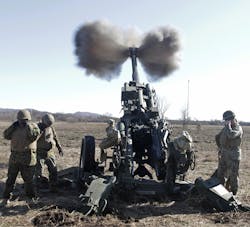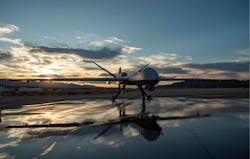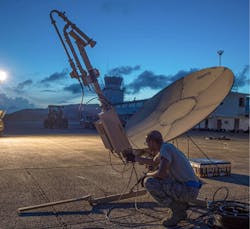Power electronics keeps today’s high-performance systems running
Aug. 2, 2022
10 min read
NASHUA, N.H. - Power electronics technologies enable military systems designers to take precise control over the amount of electrical power that flows to ever-smaller and ever-more-sensitive electronic components such as next-generation microprocessors, solid-state memory, and networking equipment.
Still, standard products and new integrated power electronics architectures can make the integration job easier and more efficient in terms of system size, weight, and power consumption (SWaP).
Gone are the days of esoteric design approaches as the U.S. Department of Defense (DOD) demands easily integratable components that can keep enabling technologies at the cutting edge. Likewise, commercial aerospace interests are embracing electronics solutions that can make autonomous passenger flight a reality.
At the crux of the military and commercial aerospace power design is how to balance what is possible with what is realistic and meet power demands and cooling requirements below the sea, on the ground, and in the air.
Power conditioning and control
Power electronics — the control and conditioning of electrical power is following technology trends in power density and SWaP. This results in innovative cooling and thermal management; adherence to open-architecture industry standards; high levels of systems integration; obsolescence management; and a reliance of commercial off-the-shelf (COTS) designs.
Andreas Heldwein, the director of defense products for IR HiRel Products - an Infineon Technologies company based in San Jose, Calif., notes that power electronics can play a key role in mission readiness and success in the mil-aero sector.
“High reliability, lightweight and compact electronics; simpler systems with greater logic and programmability; greater power efficiency and increased payload capacity - these benefits all contribute to mission readiness for space applications and operational readiness of military equipment, personal gear and weapons,” Heldwein explains.
Using technology in military applications to gain an edge is nothing new, nor is it solely the modus operandi of the United States and its allies. This spring, Heidi Shyu, the Under Secretary of Defense for Research and Engineering told attendees at the McAleese defense conference in Washington D.C. in March that commercial partners will be crucial in helping the United States and allies maintain technological superiority, particularly with China and Russia investing heavily in electronics themselves.
“[This] has amplified the criticality of strengthening our technological superiority and maintaining our military advantage, to include teamwork with our allies and partners,” Under Secretary Shyu said, noting that the COTS revolution is playing out in near-peer nations just as it is in the U.S. “”We cannot afford a leveling of technology advantage. It is imperative for the department to nurture early research in emerging technologies to prevent technological surprise. We must leverage critical state-of-the-art commercial technology where rapid advancements are trying to accelerate our military capabilities.”
Efficiency in action
Increased power efficiency with newer shipboard electronics, avionics, and vetronics is being driven by a quartet of trends according to Daniel West, a field application engineer with Kyocera AVX in Fountain Inn. S.C.
“Efficiency in power conversion is one of the biggest trends we’re supporting, West says. “In terms of passive electronic components in a given power converter design, capacitors play a huge role in overall efficiency, and there are four main ways we are responding to this trend:
“Higher Voltage Ratings. III-V semiconductors are very efficient now in a higher range of voltages and capacitor technology is keeping up to meet these requirements.
“Higher Capacitance Ratings. Bulk capacitors with higher values accommodate size/weight constrained designs. Tantalum and Tantalum Polymer capacitor technologies specifically are the most volumetrically efficient, and the latest advancements of reducing ESR (equivalent series resistance ) allows higher current flow.
“Higher Reliability. Film capacitor technology have a self-healing property to them for applications requiring an open circuit failure mode and enables efficiency further by the innovations of increased operating temperature range. In addition, there is new development for the polymer and hybrid cathode systems for those applications using aluminum electrolytic devices in their circuits that effectively improve the lifetime of this technology.
“Low Parasitic Loss. There is constant material and process improvements across all capacitor technologies to reduce losses due to temperature, frequency, and voltage, but for power conversion there is a concentrated focus on stacked ceramic, power film, and electrolytic capacitor technologies,” West concludes.
Heldwein explains how SWaP demands in power electronics are met for the military market.
“In military applications, power efficiency is key to improving size, weight and power of vehicles and equipment,” Heldwein says. “Improved SWaP could manifest as smaller batteries and/or longer battery life, reduced logistical burden of soldier-carried equipment, and greater payload capacity for vehicles and/or equipment. This leads to tactical and operational advantages in combat situations.”
Kyocera AVX’s West notes that “Efficiency in power conversion is one of the biggest trends we’re supporting. In terms of passive electronic components in a given power converter design, capacitors play a huge role in overall efficiency.”
Electronics on orbit
Of course, power efficiency also extends beyond our atmosphere as governments and commercial interests send specialty electronics into space. As NewSpace [private and public-private economic development in space] efforts continue to proliferate and make access less expensive, weight concerns become less of a concern.
“Space applications also benefit from more power efficient electronics,” IR HiRel’s Heldwein says. “However, we’re starting to see less emphasis on weight. With the newer launch vehicles, the payload cost per kilogram is rapidly declining. Higher power density in smaller footprints takes on even more importance, while still enabling additional capacity for mission payload. With 120 volts more the norm, power topologies are changing to improve converter efficiency, leading to different voltage requirements for MOSFETs.”
The metal–oxide–semiconductor field-effect transistors (MOSFETs) offered by IR HiRel include radiation hardened (rad hard) and standard hermetic versions. Standard MOSFETS are available in voltages ranging from 20 to 1000 volts, and in a wide variety of industry-standard packages. The company’s rad hard MOSFET offerings are purpose built to withstand extreme environments and have been utilized in geosynchronous and geostationary orbit, medium Earth orbit (MEO) and low Earth orbit (LEO) applications.
“In space applications, growing satellite payload processing demands drive greater use of high-power FPGAs and ASICs to handle more on-board processing, in-orbit reconfiguration, artificial intelligence on the spacecraft and more,” Heldwein says. “Providing greater flexibility and much higher data processing means that power topologies for generation and distribution must also adapt to these changing requirements.”
Launching technology into space is getting less expensive, but it’s not yet so egalitarian as to not be a concern. Heldwein says that Infineon IR HiRel’s R9 superjunction field-effect transistor technology optimizes efficiency of DC-DC converters in extreme environment applications.
“QPL-qualified, this robust power technology is already used in some of Infineon IR HiRel’s PCB-based DC-DC converters. For military and space applications, the SWaP improvements translate to greater payload capacity,” Heldwein says.
Space components by design are not generally made to be serviceable in orbit, so NewSpace businesses and governmental agencies aim to utilize electronics that are built to last. Of course, that sentiment can be applied to any governmental department/agency, business, or even consumer.
“Component longevity – long term product availability, robustness, and reliability - remain critical,” Heldwein says. “Electronics component longevity continues to be a key factor in the aerospace and military markets where we routinely see program requirements for 15-20 years or more.
For military applications, replenishing munition stock levels can happen over decades. Electronics components that adhere to the stringent certification standards help ensure robustness and long-term reliability in a wide range of operating conditions.
Heldwein concludes, “Classic space applications also demand component longevity for their decades-long programs. For deep space and long-life missions, QPL-qualified electronics remain the gold standard for ensuring robust and reliable system performance.”
Airborne implementations
Kyocera AVX’s West explains that what goes up in the world of power conversion often comes back down for use in ground and sea vehicles.
“Flight electronics are often a leading indicator of what’s to come in the world of terrestrial power conversion, and expansion of commercial-off-the-shelf product offerings in bulk capacitors is very well received,” West says, and explains “ceramic capacitors fill the needs of advanced active devices and demanding architectures with the MIL-PRF-32535 BME specification. “In addition, we are participating in the development of a MIL-PRF stacked ceramic capacitor based on MIL-PRF-32535 BME parts that builds on their strengths of low parasitic loss and high capacitance capability.
He continues, “Tantalum capacitors with MnO2 cathode systems have responded with optimized size/weight SMT devices that meet MIL-PRF-55365/12. Slash sheet 12 calls out our CWR15 devices available in 0603, 0805, and 1206 EIA case sizes. Tantalum capacitors with polymer cathode systems have responded with low ESR devices to optimize power capability with MIL-PRF-3700 devices.”
West notes that COTS tantalum polymers, like Kyocera AVX’s TCH Series, is seeing increased agency approval across the Defense Logistics Agency and the National Aeronautics and Space Administration in the U.S. as well as the European Space Agency.
“Proper selection of capacitors will ensure long-term reliable use in end applications,” West explains. Electronics component longevity continues to be a key factor in the aerospace and military markets where we routinely see program requirements for 15-20 years or more. “For military applications, replenishing munition stock levels can happen over decades. Electronics components that adhere to the stringent certification standards help ensure robustness and long-term reliability in a wide range of operating conditions.”
Heldwein agrees, saying, “For LEO space, short-duration and high-redundancy mission applications, we also see use of automotive-qualified electronics. However, we expect that rad hard electronics will continue to play a central role in long mission and deep space applications.
He continues, “Along with our high-reliability and rad hard memory, RF and power solutions, Infineon also has an extensive offering of commercially available, automotive-qualified components. We see market interest to consider integration of COTS automotive and MIL-PRF-19500 / MIL-PRF-38534 / MIL-PRF-38535 qualified devices into products for defense applications.”
Taking the heat
Doing power-intensive tasks in hostile and extreme environments can result in an abundance of heat that needs to be dissipated. This can be alleviated by enabling passive or actively cooling the electronics or reducing the amount of heat produced by increasing efficiency.
“We are specifically looking at the DC-DC converters, AC-DC converters, power conversion, batteries, power over RF networking, power generation, and renewable energy,” Kyocera AVX’s West says, and notes that thermal management will be key in the company’s power conversion circuitry. “Our Q-Bridge is a unique device that is an SMD thermal conductor in familiar and small EIA case sizes. It can be terminated directly on active pins because it has extremely low capacitive loading but still routes heat efficiently away from active elements,” West says. “The voltage ratings on these devices are inherently high which falls in line with the upward trend of operating voltages.”
Speed and size
Thanks to electronics, guided munitions are able to enable increased precision over longer ranges, which means a lower risk of collateral damage.
“As governments work to extend artillery projectile range capabilities, guided, smart munition systems will become critical to increase precision over longer distances, IR HiRel’s Heldwein explains. “These long-range precision munitions reduce the time, cost and logistical burden for artillery forces.”
Size still matters in the mil-aero industry though, and according to West, Kyocera AVX’s J-CAP series of conductive polymer capacitors answers the call for miniature high reliability SWaP performance.
“Smaller low-loss passives easily fit in with next generation power conversion topologies and chipsets,” says West. “Our J-Cap devices have such large capacitance values that it can be thought of in millijoules, hence the moniker ‘J-cap’, and provides large amounts of energy relative to it’s SMD form factor. The TWM series are wet tantalum technology in a different form factor but store even more energy. Supercapacitors of course, known for storing vast amounts of energy for battery supplement/replacement and energy harvesting applications will see use in this industry as modules with high reliability become prevalent.”
About the Author
Jamie Whitney
Senior Editor
Jamie Whitney joined the staff of Military & Aerospace Electronics in 2018 and oversees editorial content and produces news and features for Military & Aerospace Electronics, attends industry events, produces Webcasts, and oversees print production of Military & Aerospace Electronics.
Sign up for our eNewsletters
Get the latest news and updates
Sponsored




